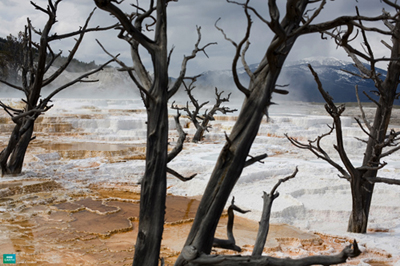This post courtesy BBC Earth. For more wildlife news, find BBC Earth on Facebook and Posterous.
Once hailed as “America’s best idea,” Yellowstone was the world’s first national park. Changing the way we interact with nature, the Pulitzer prize-winning author Wallace Stegner put it best when he said national parks “reflect us at our best, not our worst.”
In the gigantic 3.5million square miles of land, Yellowstone is host to a large number of interesting animal species, including bison, cougars, lynx, bobcats and coyotes.
The whole park actually sits on a caldera, often referred to as a “supervolcano,” and has at its heart the same conditions that brought about the start of life on Earth. This means it holds one of the world’s natural wonders, as you can see in this video.
The volcano means Yellowstone remains geologically very active. Recent changes in the volcanic springs have killed these pines by cooking their roots, as the branches freeze in winter.
 It’s safe to say that Yellowstone is a place of natural beauty that’s inspired conservation and preserved countless areas of outstanding natural interest around the world.
It’s safe to say that Yellowstone is a place of natural beauty that’s inspired conservation and preserved countless areas of outstanding natural interest around the world.











